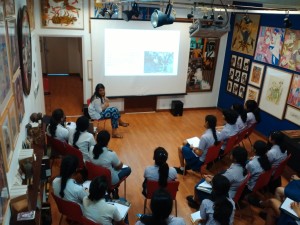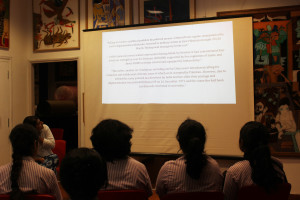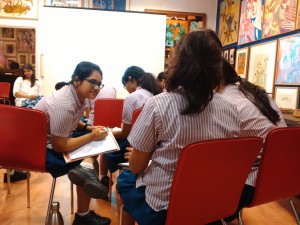On 29 September, Meher Ali, a Fulbright scholar from Brown University conducted a session on ‘Understanding 1971’ with 17 high school students from Modern High School for Girls and Lakshmipat Singhania Academy. This was the first talk for students as a part of the History for Peace project. Using various audio visual aids, including a trailer of the film Meherjaan and excerpts from textbooks for school students in the subcontinent, Meher guided the participants through an analysis of sources of history.
Below is a report written about the session by Yashita, a participant from Modern High School.
As students of History, we are constantly encouraged to question the facts which are put before us. It is important to maintain some level of objectivity and analyse different sources and points of view to truly gain knowledge of an event which took place.
This idea was reinforced in us by Miss Meher Ali, who conducted a session at the Seagull Foundation for the Arts in Kolkata on the Bangladesh Liberation War of 1971. Twelve students of class XI and XII from Modern High School were given the opportunity to attend this session, which we are extremely grateful for.
The war of 1971 was a gruesome one, resulting in great losses on both sides. As a result of this, Bangladesh, or East Pakistan as it was known then, gained independence with the help of India. We watched clips from an Indian documentary and a Bangladeshi documentary made about this war. It was interesting to note the difference in the way the war was depicted in the two. We also read out descriptions of the war from the prescribed History text books in the three countries. Furthermore, we analysed newspaper articles and personal accounts of people involved in the war.
While the Indian sources spoke mainly about the great contribution of India in the war, the Bangladeshi sources stressed on the brutalities and oppression faced by them-how they were massacred by the ruthless, immoral Pakistani soldiers. The sources from Pakistan, on the other hand did not give too many details about the war and simply mentioned that after a lot of fighting and a series of violent killings, East Pakistan broke away and proclaimed itself to be an independent country. Thus, only by reading a few examples we could tell how differently the war is portrayed in the three different countries. While Bangladesh and India blame the evils and oppression of Pakistan for the war, Pakistan blames anti-nationalist feelings and Indian influences for causing the war. This showed us how an event can be distorted and depicted according to how people want us to see it. The war is surrounded by a lot of controversy till today. Even statistics cannot be fully trusted as they can easily be skewed.
The session concluded with a fun activity, in which we were divided into groups and asked to summarize the session we just attended in different ways and from different perspectives. It was extremely interactive; we were given the freedom to share our ideas, opinions and insights. Apart from giving us a lot of information about the war, the session also taught us how we must gain as much information as we can from all possible sides about an event to conduct proper research. It is essential to find the right balance between different sources of information- personal interviews, articles and statistics in order to properly present an event in History. Historians indeed have an extremely difficult task to balance point and counterpoint.
– report by Yashita Khandari
Class XI, Modern High School



